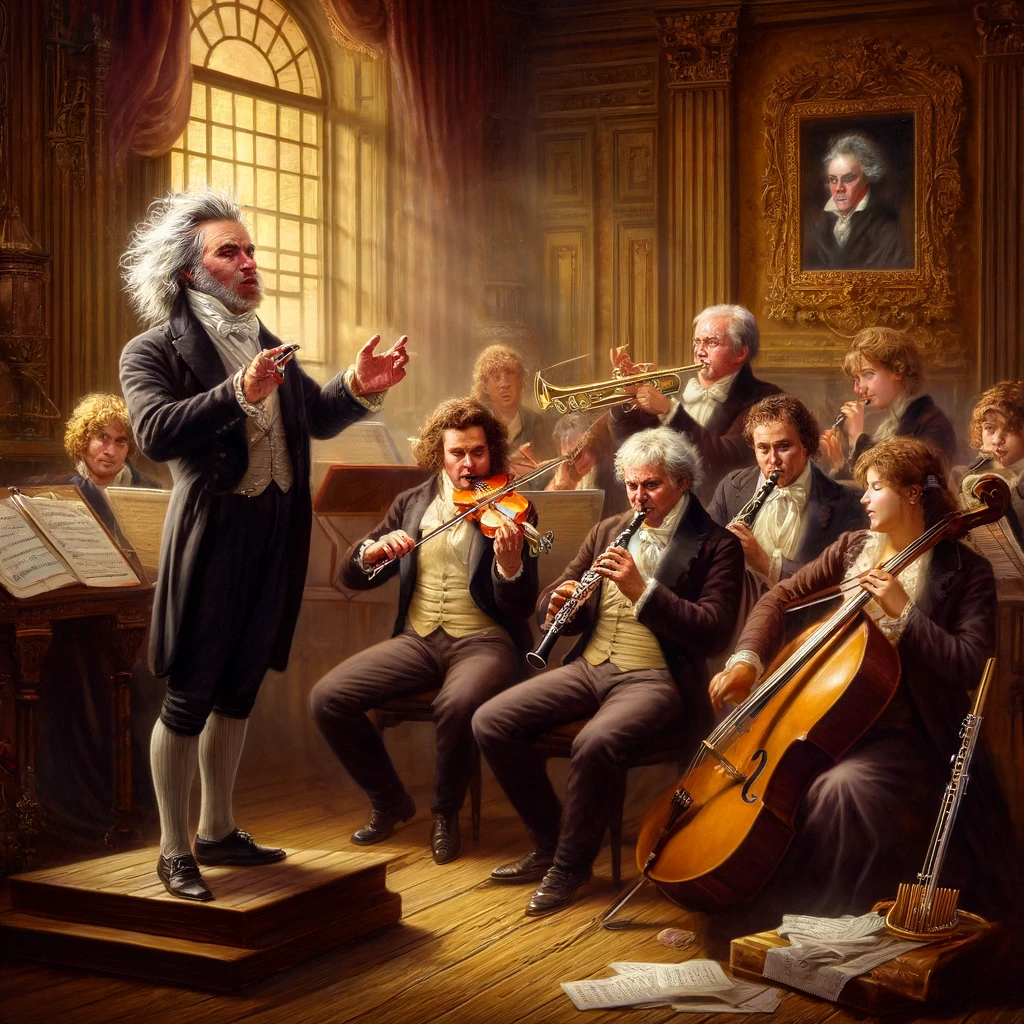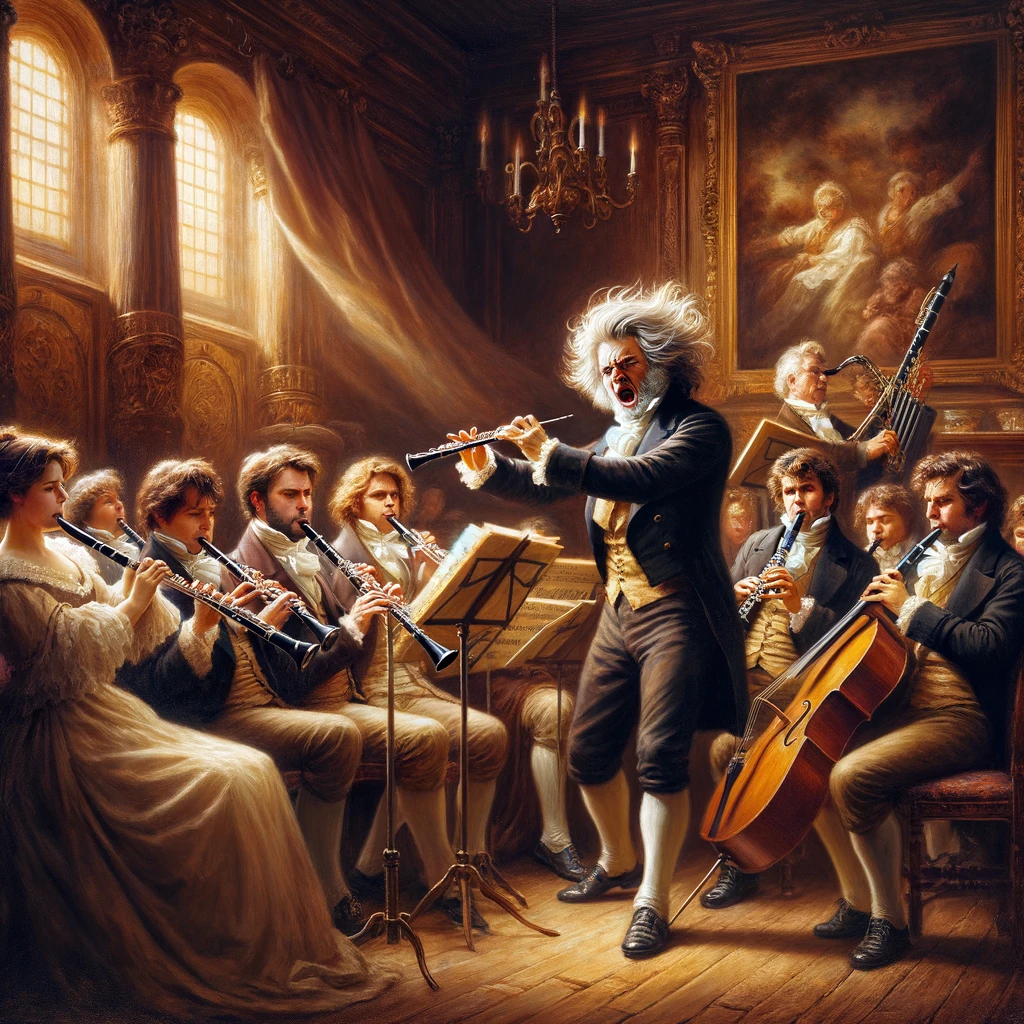
Exploring Beethoven’s Wind Chamber Works
Ludwig van Beethoven, a colossal figure in the realm of classical music, is best known for his symphonies and sonatas. However, his contributions to chamber music, particularly those involving wind instruments, are equally deserving of attention for their innovative qualities and profound expressiveness. This article explores the lesser-known chamber works featuring winds by Beethoven, offering insights into their creation, characteristics, and the unique place they hold in classical music.
The Innovation Behind the Compositions
Beethoven’s approach to composition was revolutionary, and his works for wind instruments in chamber settings are no exception. During his time, wind instruments were undergoing significant developments, which expanded their technical capabilities and expressive range. Beethoven seized these advancements with enthusiasm, integrating winds into his chamber music in ways that had seldom been explored before.
One of the earliest examples is his “Quintet for Piano and Winds in E-flat Major, Op. 16”, composed in 1796. This piece, scored for piano, oboe, clarinet, horn, and bassoon, mirrors the structure and style of Mozart’s quintet K. 452. However, Beethoven’s quintet presents a bolder approach in the handling of the wind instruments, often giving them lines that are as demanding and prominent as those of the piano. This work not only highlights the individual characteristics of each wind instrument but also demonstrates how effectively they can interact with the piano as equal partners.
Highlighting Individual Voices
Beethoven’s “Septet in E-flat major, Op. 20”, composed in 1800, is another significant work that features winds prominently. The septet includes a clarinet, horn, and bassoon alongside a string quartet. This composition stands out for its democratic treatment of each instrument, allowing individual voices to emerge clearly in a conversational and interwoven manner. The third movement, “Tempo di Menuetto”, in particular, showcases the lyrical capabilities of the clarinet, while the horn plays a crucial role in balancing the ensemble’s sonority.
The Late Masterpieces
As Beethoven’s hearing deteriorated, his compositions revealed a deeper introspection and innovation. The “Duo for Clarinet and Bassoon in B-flat major, WoO 27, No. 3”, composed around 1810, is an example of his later style. This work is notable for its playful interaction between the clarinet and bassoon, featuring call and response sequences that are both humorous and technically challenging. It reflects Beethoven’s continued interest in exploring the possibilities of wind instruments, even in his more personal and less public compositions.
Integration in Larger Contexts
Beethoven also integrated wind instruments into larger chamber ensembles with significant effect. His “Wind Octet in E-flat major, Op. 103”, originally composed in 1792 and later rearranged as a String Quintet, Op. 4, demonstrates his skill in handling larger groups of winds. The octet is scored for pairs of oboes, clarinets, bassoons, and horns, creating a rich tapestry of timbres and interactions that predates the more famous “Septet”.
Impact and Legacy
The impact of Beethoven’s wind chamber works extends beyond their immediate appeal. They influenced contemporaries and subsequent generations of composers to consider wind instruments as more integral to chamber music. This shift helped pave the way for the rich repertoire of 19th and 20th-century wind music, from the romantic woodwind serenades of Brahms to the intricate wind quintets of Carl Nielsen.
Beethoven’s works for winds also reflect a broader trend in his compositional style: a move towards more personal, expressive music that communicates directly and powerfully with the listener. Through these compositions, Beethoven not only explored the technical potentials of new instrumental developments but also expanded the expressive possibilities of music itself.
While Beethoven’s symphonies and piano sonatas may dominate the spotlight, his chamber works featuring wind instruments are treasures that reveal another facet of his genius. These compositions showcase his ability to bring out the unique voices of wind instruments, blending them seamlessly with strings and piano, and elevating them to a symphonic level of artistry. Exploring these works gives us a deeper appreciation of Beethoven’s legacy as a pioneer of musical expression and a master of orchestration.

The Role of Wind Instruments in Beethoven’s Theatrical and Vocal Works
Beyond the chamber music setting, Beethoven’s use of wind instruments in his theatrical and vocal works also warrants attention. For instance, in his opera “Fidelio”, the wind parts are not merely accompaniment; they enhance the narrative and deepen the emotional impact of the scenes. In the famous “Prisoners’ Chorus”, the winds contribute to a texture of hope and sorrow, illustrating Beethoven’s mastery in using these instruments to support vocal lines and dramatic contexts.
Technical Challenges and Innovations
Beethoven’s writing for wind instruments was often technically demanding. This is evident in the “Trio for Two Oboes and English Horn in C major, Op. 87”. This composition is challenging for the performers due to its intricate lines and the stamina required. Yet, it is precisely these challenges that allow the music to flourish, highlighting the agility and expressivity of the winds. The trio format, rare at the time for such instruments, showcased Beethoven’s inventive use of wind timbres and his ability to create a compelling musical dialogue.
Educational Contributions
Interestingly, some of Beethoven’s wind music also had a pedagogical intent. The “Octet in E-flat major, Op. 103”, was originally written for the students of the Imperial and Royal Seminary in Vienna. Through this composition, Beethoven not only provided a learning tool for young musicians but also contributed to the educational repertoire for winds, enriching the academic resources available at the time.
Personal Expression Through Wind Instruments
Beethoven’s personal connection to his compositions often manifested in his choices of instrumentation. The “Horn Sonata in F major, Op. 17”, is a prime example. Written for the horn virtuoso Johann Wenzel Stich (who performed under the Italianized name Giovanni Punto), this sonata combines virtuosic demands with lyrical passages that explore the full expressive range of the horn. The work reflects Beethoven’s respect for the capabilities of the horn as well as his intent to push the boundaries of what the instrument could achieve in a classical format.
Influence on Later Composers
The innovative characteristics of Beethoven’s wind compositions did not exist in a vacuum. They influenced many composers who followed, encouraging a greater appreciation and utilization of wind instruments in chamber music. Composers such as Franz Schubert, who admired Beethoven greatly, took inspiration from these works. Schubert’s “Octet in F major, D. 803”, for instance, clearly echoes the textures and instrumentation of Beethoven’s Septet, yet with Schubert’s own lyrical style.
Conclusion
Beethoven’s exploration of wind instruments in his chamber works represents a significant aspect of his musical legacy. These compositions not only demonstrate his technical prowess and creative genius but also his ability to infuse music with deep emotion and personal expression. They challenge performers and engage audiences, offering a richer understanding of the capabilities of wind instruments in classical music.
Exploring Beethoven’s chamber works featuring winds allows us to appreciate his broader impact on music history. His compositions continue to influence musicians and composers, ensuring that his innovations and his spirit of exploration in music remain alive and relevant.
Through these lesser-known yet profoundly impactful works, Beethoven remains a towering figure in the classical music landscape, not only as a composer of great symphonies and sonatas but also as a master of intimate, expressive chamber music. This exploration into his wind chamber works enriches our understanding of his artistic breadth and deepens our appreciation for his enduring genius.
References
- Beethoven, L. van. Quintet for Piano and Winds in E-flat Major, Op. 16.
- Beethoven, L. van. Septet in E-flat major, Op. 20.
- Beethoven, L. van. Duo for Clarinet and Bassoon in B-flat major, WoO 27, No. 3.
- Beethoven, L. van. Wind Octet in E-flat major, Op. 103.
- Beethoven, L. van. Trio for Two Oboes and English Horn in C major, Op. 87.
- Beethoven, L. van. Horn Sonata in F major, Op. 17.
- Beethoven, L. van. Fidelio, Opera, Op. 72.